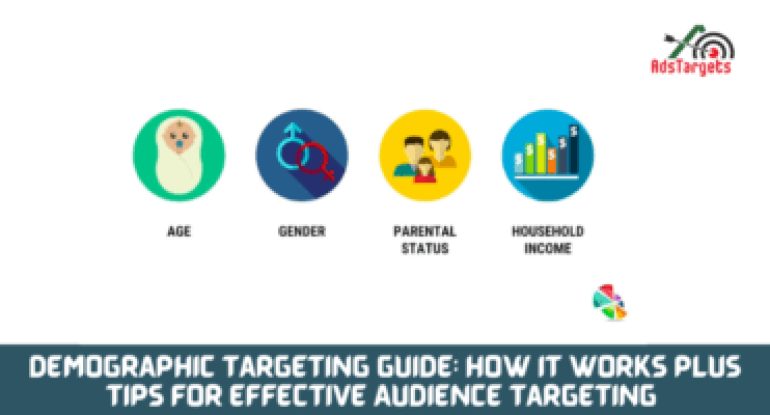Updated 15/05/2025
Your business should have a product that addresses the pain points (either acts as a pain killer or vitamin) to a defined set of customers and prospects.
This will increase the demand for your product and sell like a hot cake in any market to those whose pain points you are out to treat.
Demographic targeting is important to understand and consider in your marketing campaigns since most products appeal more to some demographics but not to others.
For example, as more people in the US live alone, and fewer people are confident cooking, or have the set-up and stocked kitchens to cook when they have the time, companies that offer prepackaged meal kits, takeout meals, or frozen single-serve options have grown by targeting this set of demographic.
It’s important as a marketer to be aware of demographic trends in and outside of your current markets.
In this guide, I will walk you through beneficial routes toward marketing success by leveraging demographic targeting.
Table of Contents
ToggleWhat is Demographic Targeting?
Demographic targeting is a type of marketing segmentation that divides the market according to family size, religion, gender, education, age, ethnicity, and even income.
The data from this can be divided into different markets, which allows companies to target consumers accurately.

How Are Demographic Targeting Used In Marketing?
Marketing perspectives can be broken down into two unique areas concerning demographic targeting, which are micro-demographics and macro-demographics.
#1. Micro-Demographic Perspective
Individuals or households within the same socioeconomic group share specific patterns of behaviors, attitudes, beliefs, and values.
The concept of segmenting prospective consumers with similar buying tendencies goes back to 1956 when Wendell Smith, a research scholar, introduced the idea of market segmentation to the marketing literature in his article ‘Product differentiation & market segmentation as alternative marketing strategies.’
He recommended that businesses should focus on consumer needs instead of business requirements. Most marketers have applied this to their email marketing strategy, if you haven’t, then you are not only decades behind in this fiercely competitive market but also losing out on one of the best strategies to connect with your consumers.
Micro-demographic perspective is the process of categorizing consumer groups according to their needs, wants, and similar feedback to a marketing action.
These factors might be influenced by other supporting factors like where they live. As various market stimuli can have various impacts on individuals in the same subgroup,
Micro-demographic targeting is a marketing strategy that teaches you something new every day.
Advantages Of Micro-Demographic Targeting
#1. Streamlines Productivity
When you have enough data to identify and implement segmentation, you are all ready to deliver a customer-satisfied business.
Micro-demographic targeting is nothing but a loop of targeting the right customer and sending them the right content, at the right time to make them take quicker and more positive purchase decisions to solve their pain points.
This not only offers you the direction to adopt a feasible approach to email marketing but also helps you come up with a workable strategy to communicate better with your target audience.
#2. Accountability
With micro-demographic targeting, you can not only identify smaller and larger consumer groups but also decide how much to invest based on the fruitfulness of each segment.
This is necessary as the dynamics of each segment are different and to meet wide-ranging customer demands, micro-demographic segmentation is your best bet.
Sending out the right content to the right audience at the right time will boost the chances of an accelerated purchase and build a better rapport with the customer.
#3. Better Performance
A marketer’s worst nightmare is when they spend days sweating out an email strategy, copy, design, and code, only to see it end up in the spam box.
Not only is this injurious to your ISP reputation, but you are also losing customers. According to a survey conducted by Infosys, 78% of consumers said that if a company had provided more targeted products they would likely make multiple purchases. Sending relevant emails will offer you better CTR, response, and an enhanced ROI.
#2. Macro-Demographic Perspective
Macro segmentation is broader in scope than micro-segmentation, which concentrates the target on a small customer base.
With Macro segmentation, characteristics of whole populations (national,) (multinational) that a business seeks to succeed in a particular market.
These factors include size, location, and other factors that often affect consumer behavior. These factors may be economic forces such as income levels and customer preferences for certain goods and services sold by a company.
Advantages of Macro-Demographic Targeting
#1. It helps define the scope or area of activity of the business and, therefore, it helps to focus on this area instead of being tempted to do a bit of “everything”.
#2. It helps to understand which market you are targeting and, therefore, what needs must be satisfied to offer value to that market.
How Important Are Demographic Targeting In Online Marketing?
In a fiercely-competitive marketing realm, analyzing demographics to come up with key conclusions and supercharge a target audience is a basic must.
Utilizing certain analytical tools, marketing research specialists take advantage of the power of demographic targeting to create effective email marketing campaigns, content marketing initiatives, and a set of actions that enable companies to offer a tailor-made experience to customers.
Demographic targeting help advertisers identify the individual members of their audience by key characteristics, wants, and needs.
You can use demographic targeting to refine your marketing budget and make more targeted investment decisions about how to engage your target group.
Demographic targeting allows marketers to determine which subgroups appear to exist in the entire population.
It allows businesses to create a crystal-clear picture of the situation and characteristics of a specific part of one of those marketing groups.
With proper use of demo targeting, this can remarkably help marketers to target the right audience reducing the unnecessary cost spent on impressions which in the long run saves budget.
Demographic targeting allows marketers to identify the potential audience for ads and products meant for a specific population segment with shared traits.
Another great advantage of demographic targeting is the following_the fact that it almost guarantees amazing loyalty and massive customer retention.
When companies decide to commit a large swath of time to concentrate on consumers, their needs, and desires, customers will tend to be back for additional business.
A sense of trust and loyalty is exceedingly crucial and that’s why customer retention through market segmentation is a successful way to create an effective marketing strategy.
How To Use Demographics Targeting To Understand Your Audience

#1. Analyze the Realm
This is the first step in the project. Go through some research, checking the demographics of a particular region, country, or parish you are planning to target.
It’s time to find out as much as you can about the population makeup. Find out about the following market segmentation:
#1. Gender
#2. Occupation
#3. Family Environment
#4. Income Level
#5. Education
#6. Age
Spending time online and taking as much insight as possible from, previous research, graphs, charts, past marketing research studies, user research, and others is a basic part of this stage.
Market segmentation experts investigate customer trends, popular buying patterns, behavioral triggers, customer behavior, and plenty more aspects to be able to create a specific and highly-accurate idea of their target audience.
#2. Geography and Lifestyle
Another fundamental aspect of the customer segmentation and demographic targeting game? To get to know how and where the target consumers live.
They could be city youngsters who love to stay up late and dive into nightclubs. They could be wealthy retirees who live off a generous pension and concentrate on buying products that advertise health-related aspects.
Are they politically conservative or they are liberals? Do they spend 12 hours working or 12 hours watching TV? Where do they spend their time the most?
This data will allow target segmentation professionals to create a highly-customized marketing campaign that hits all the right notes through the successful use of targeted power.
#3. Focus On Customer Needs Instead of Business Requirements.

Why do people leave their homes in the cold, spend hours in the food aisle and decide to buy product A instead of B? Why does it matter if the carton color is orange, blue, or silver?
Knowing the psychological factors that entice users into specific products is a major step in the target demographic technique.
Marketing pros get to consider all of the psychological factors why some people might want to purchase a specific product but not another. For this reason, they must dive into their heads and learn their priorities, requirements, tastes, needs, and more.
At this stage, there needs to be some type of communication with potential customers. It could be a conversation, a phone call, a quiz, or a survey that will enable marketers to gather customer data and help experts understand everything they should know about customer behavior to add up to their entire research.
Once the basic demographic factors have been taken into account, marketers assemble what is known as a consumer profile.
This is a focused statement that will define the target audience in perfect detail. The profile is consulted, checked, and analyzed time and time again; to ensure marketers get to know full well what their customers want and who they are, creating tailor-made marketing content that yields results.
Conclusion
Demographic targeting is cost-efficient as it allows you to craft tailored messages, ensures direct targeting generates faster results, earns more leads, improves customer loyalty, and supercharges the power of word-of-mouth marketing.
By using the massive boon of demographic targeting research, you get to understand what your target markets look like, their points, what they need, their behavioral patterns, their purchasing patterns, and what type of marketing strategy to go for into to connect with them rightly.
This means that, by performing thorough market and customer research, you get to create custom-made marketing initiatives that not only become highly beneficial but also ensure massive customer retention and business growth.








